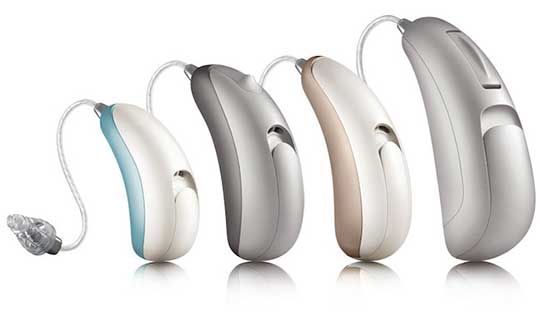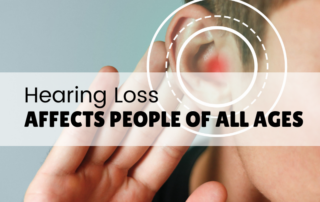Hearing Aids and Rehabilitative Services
Port Huron Hearing and Balance Center offers a range of hearing aid styles and technology levels meeting your listening needs and budget.

Hearing Aids
Technology and lifestyle affect your choice
Hearing aid sizes range from completely in the ear (ITE) to behind the ear (BTE).
Due to wear and tear, exposure to cerumen and the temperature in the ear canal, ITE aids usually perform for 5-7 years. BTE hearing aids last longer needing minor modifications due to the ear growing slightly over time. Technology and multiple microphones have improved a patient’s ability to localize and lateralize multiple sound sources in any size of hearing aid. This makes selecting the size more of a cosmetic decision, than aerodynamic need to place the microphone at the point of the concha.
Bluetooth smartphone integration and other modern features fit seamlessly into daily life
 Today’s hearing aids have a variety of technological enhancements such as Bluetooth support for iPhone and Android. The Remote Plus app (for Unitron) allows users to adjust volume, change programs, and adjust the balance of their hearing aid — all from their smartphone. You can even stream calls right through your hearing instrument!
Today’s hearing aids have a variety of technological enhancements such as Bluetooth support for iPhone and Android. The Remote Plus app (for Unitron) allows users to adjust volume, change programs, and adjust the balance of their hearing aid — all from their smartphone. You can even stream calls right through your hearing instrument!
The TV Connector accessory works with laptops, tablets, TVs and stereos can allow users to enjoy high-quality stereo sound through their hearing aid. Rechargeable batteries and remote accessories further enhance convenience.
The level of technology depends on the patient’s hearing loss, listening needs, situation, and expectations
Just 20 years ago most hearing aids were simply analog. If the single microphone received a sound, whether speech or the refrigerator running the hearing aid amplified it and created the complaint that hearing aids are “noisy”. When a patient has an active lifestyle with even moderately challenging listening situations, they perform better with more advanced technology. It provides them with higher fidelity, a multiple band signal processing system, multi-channel compression and other features for a comfortable, pleasant listening experience.
We also offer other types of assistive listening devices, hearing protection solutions, and swim molds.
Examples of Hearing Aids
There are a large variety of hearing aids to choose from, depending on your lifestyle and needs. Let our audiologists help you select the perfect one. Here you will find some examples of the common types of hearing aids, and you may wish to visit Unitron, and Oticon for additional information.
Get The Most Benefit From Your Hearing Aid
Communication strategies and tips
Most importantly – wear your hearing aids! Without making yourself uncomfortable in the adjustment process, build up to wearing the hearing aids all day. This will give your brain consistency in all the auditory information it receives.

Top communication strategies for success
Do I need two hearing aids?
For almost everyone, the answer is YES!
Having two ears working and having them on each side of the head gives us advantages.
Related Articles
When Should I See An ENT Doctor?
If you have symptoms related to your ears, nose, or throat, it's a good idea to see an ENT provider. ENT doctors are specialists who are trained to diagnose and treat conditions affecting these areas of the body. Some examples of when you may want to see an ENT doctor include if you are experiencing chronic ear infections, sinus infections, allergies, and snoring.
Hearing Loss at Holiday Celebrations
The holiday season is officially upon us, and all the joyous festivities and family gatherings that come with it! But if you are suffering from hearing loss, big family get-togethers can present a unique set of obstacles. It isn’t always obvious to others you’re experiencing, and it can be easy to misinterpret hearing challenges as frustration, anger, or withdrawal.
Hearing Loss Affects People Of All Ages
Do you work in a noisy place, use headphones regularly, or visit places with loud music? There are many ways to make listening safe, and with over a billion young people at risk of avoidable hearing loss due to recreational sounds (Airpods, earbuds, concerts, loud music, bars), hearing loss is a real concern for people of all ages. 1 in 2 young people are at risk of hearing loss due to unsafe listening.









